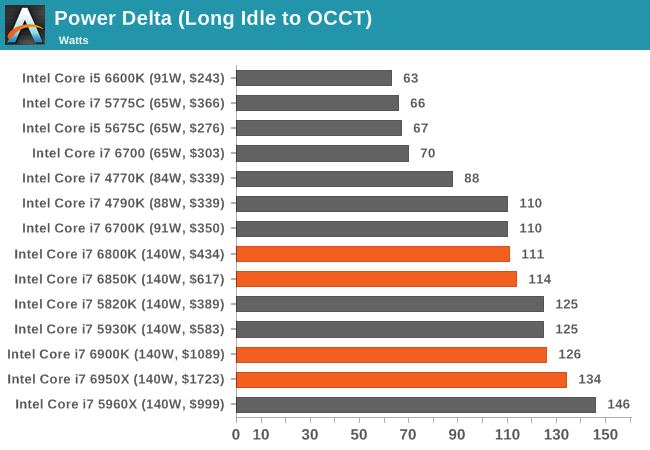The Intel Broadwell-E Review: Core i7-6950X, i7-6900K, i7-6850K and i7-6800K Tested
by Ian Cutress on May 31, 2016 2:01 AM EST- Posted in
- CPUs
- Intel
- Enterprise
- Prosumer
- X99
- 14nm
- Broadwell-E
- HEDT
Load Delta Power Consumption
Power consumption was tested on the system while in a single MSI GTX 770 Lightning configuration with a wall meter connected to the OCZ 1250W power supply. This power supply is Gold rated, and as I am in the UK on a 230-240 V supply, leads to ~75% efficiency > 50W, and 90%+ efficiency at 250W, suitable for both idle and multi-GPU loading. This method of power reading allows us to compare both the power management of the BIOS and the board's ability to supply components with power under load, and includes typical PSU losses due to efficiency.

Each of the Broadwell-E SKUs are rated at 140W, however they vary between 6 cores and 10 cores and with different frequencies. Normally one would assume that the core/frequency ratio would be adjusted to match TDP, but ultimately using more cores can consume more power. We see a distinct increase in power consumption moving up the product stack.
Prime95 Core Loading
For this review, we also looked into peak delta power draw when varying the number of cores using Prime95’s mode for peak power consumption. Prime95 identifies cores with multiple threads and adjusts its loading/pinning accordingly.

Broadwell-E Overclocking
Methodology
Our standard overclocking methodology is as follows. We select the automatic overclock options and test for stability with PovRay and OCCT to simulate high-end workloads. These stability tests aim to catch any immediate issues with memory or CPU errors.
For manual overclocks, based on the information gathered from previous testing, we start off at a nominal voltage and CPU multiplier, and the multiplier is increased until the stability tests are failed. The CPU voltage is increased gradually until the stability tests are passed, and the process repeated until the motherboard reduces the multiplier automatically (due to safety protocols) or the CPU temperature reaches a stupidly high level (100ºC+). Our test bed is not in a case, which should push overclocks higher with fresher (cooler) air.
Overclock Results
Due to time constraints we were only able to overclock the i7-6950X using the MSI X99A Gaming Carbon motherboard. MSI has improved its overclocking options as of late on the Z170 platform to make it easier to use, but our BIOS did not have those most recent updates, particularly for load line calibration. However, our sample hit 4.1 GHz at 1.30 volts before the OCCT load temperatures were prohibitive to move up any further. We saw similar things when testing the mainstream Broadwell parts with Iris Pro, which shows that this sort of overclocking performance might be indicative of the silicon itself.
That being said, speaking with our contacts at various motherboard manufacturers, we're told that 4.1 GHz is a reasonably average processor result for Broadwell-E. Some processors will hit 4.3 GHz on air at around the same voltage, whereas others need up to 1.4 volts, and thus results will depend on the cooling setup used or the thermal characteristics of the silicon. I have also been told that AVX is a different story: for any peak frequency attained normally, AVX overclock stable frequencies will be around 200-300 MHz lower.











205 Comments
View All Comments
mapesdhs - Thursday, June 9, 2016 - link
Or a used 3930K, they cost diddly now. Use the cost saving on better SSDs, faster RAM, etc.rtho782 - Tuesday, May 31, 2016 - link
Wow.Minor performance boosts at best was expected and I could swallow that and still be excited for BDW-E.
Minor performance boosts and a 70% price boost? I won't bother upgrading then.
ShieTar - Tuesday, May 31, 2016 - link
There is no 70% price boost. The 6900K that replaces the 5960X basically sells at the same price with a good 10% performance boost.The 6950X needs to be compared to last generations E5-2687W V3, which still costs more than 2k$. So Intel actually hands out a 10% to 15% performance boost with a 20% price drop on that front:
http://www.anandtech.com/bench/product/1730?vs=135...
pencea - Tuesday, May 31, 2016 - link
It's been10 days since the embargo on GTX1080 reviews was lifted and previews aside, there is still a deafening silence from Anandtech. Yes the apologists will argue Anandtech does a deeper review, give them time and all that but seriously when your review is this late, it begins to look like incompetence. Or perhaps you consider your reviews to be elitist, the holy grail among tech websites and that therefore any delay is acceptable? What pressing projects are the GPU staff working on that could explain this state of affairs?GET IT TOGETHER ANANDTECH YOU USED TO BE BETTER!
Ryan Smith - Tuesday, May 31, 2016 - link
"there is still a deafening silence from Anandtech"Feedback is always appreciated. I've mentioned a few times now that it's not done yet and is still in the works. But I'm not sure what else you're looking for?
D. Lister - Tuesday, May 31, 2016 - link
In other news, Guru3D has recently put up their 1070 review. Next time guys, use "Review: Part 1" in title, instead of calling it a "Preview". :Pretrospooty - Tuesday, May 31, 2016 - link
He is looking for it to be done, and not "in the works". =)HighTech4US - Tuesday, May 31, 2016 - link
^ T H I SHighTech4US - Tuesday, May 31, 2016 - link
Quote: But I'm not sure what else you're looking for?An actual review.
artk2219 - Monday, June 6, 2016 - link
Sigh, you can't please everyone, and thank you for taking the time and effort to do these reviews in the first place. As always, I look forward to it and hope to see it whenever it's ready.Thank you!